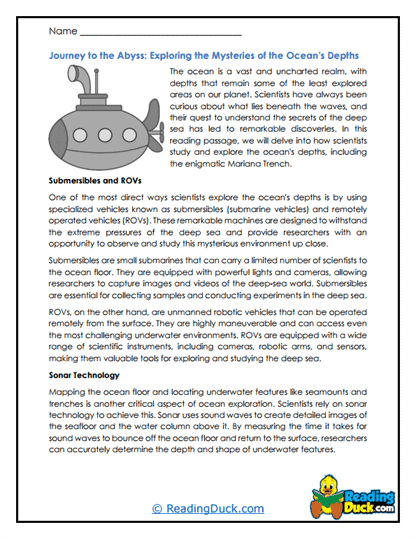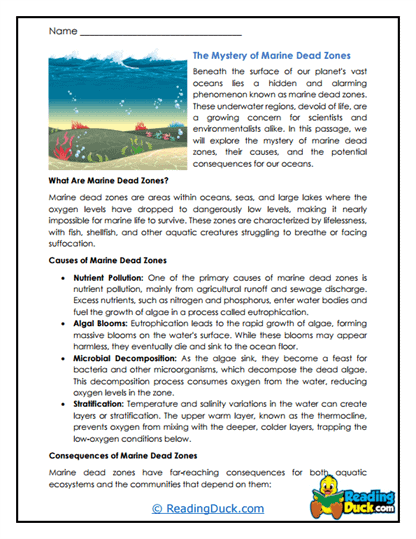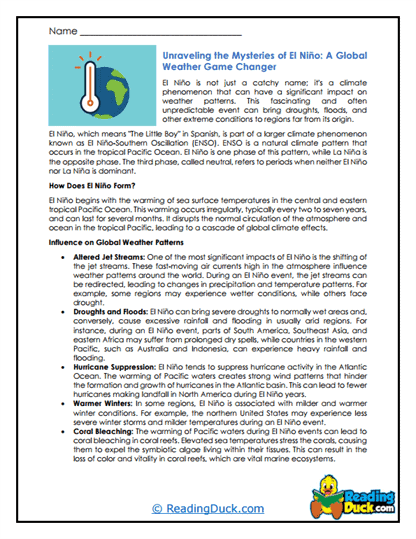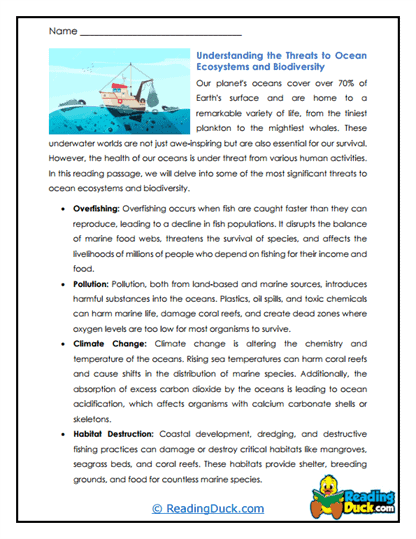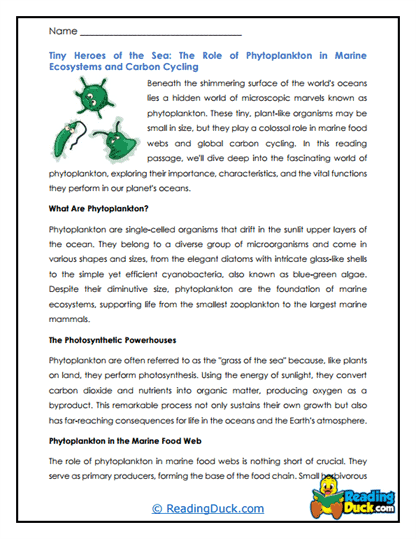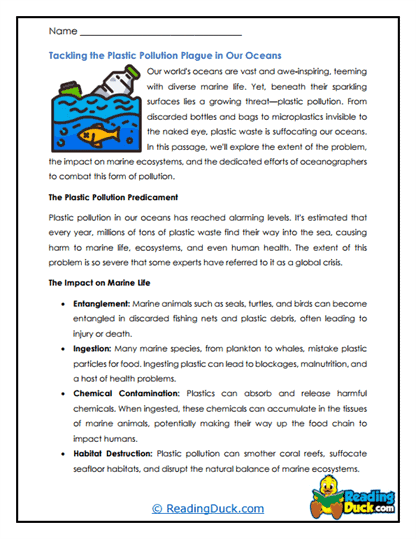Oceanography Worksheets
About Our Oceanography Worksheets
Our Oceanography worksheets provide a comprehensive exploration of the world’s oceans, covering various aspects of this fascinating and vital Earth Science subtopic. This collection delves into the physical, chemical, and biological processes of the ocean, offering students an in-depth understanding of the vast and complex marine environments.
Each worksheet set is thoughtfully designed to engage students and deepen their understanding of oceanography:
- Multiple Choice Questions: These questions assess students' comprehension of the reading passages, ensuring they grasp the key concepts and details about oceanography.
- Short Answer Questions: These questions encourage students to express their understanding in their own words, fostering critical thinking and the ability to articulate scientific concepts clearly.
- Open-Ended Questions: These questions invite students to reflect on what they’ve learned, connect the information to their own experiences, and share their personal opinions or preferences related to the ocean and its ecosystems.
These worksheets also include an answer key for every question sheet, making it easier for teachers and parents to evaluate students' understanding and provide constructive feedback. The worksheets are available in PDF format, allowing for easy access, download, and printing, making them convenient for both classroom and homeschool use.
Dive into Oceanography: Understanding the World’s Oceans
1. The Basics of Oceanography: Exploring the Ocean’s Depths
- What Is Oceanography?
- Definition and Importance:
- Oceanography is the scientific study of the ocean, including its physical, chemical, biological, and geological aspects. The field plays a crucial role in understanding how the ocean influences global climate, weather patterns, and the overall health of our planet. By studying oceanography, students gain insight into the dynamic processes that shape our world and sustain life on Earth.
- Key Areas of Oceanography:
- Physical Oceanography: Focuses on the movement of ocean waters, including currents, waves, and tides. Understanding these physical processes is essential for navigation, climate prediction, and marine resource management.
- Chemical Oceanography: Investigates the chemical composition of seawater and the cycles of chemical elements within the ocean. This area of study is vital for understanding the ocean’s role in the global carbon cycle and its impact on climate change.
- Biological Oceanography: Examines the organisms that live in the ocean and their interactions with the environment. This includes the study of marine ecosystems, food webs, and the biodiversity of ocean life.
- Geological Oceanography: Explores the structure and composition of the ocean floor, including the formation of underwater features like mountains, trenches, and volcanoes. This area of study helps us understand the history of Earth and the processes that have shaped its surface.
- Definition and Importance:
2. The Ocean Environment: A Dynamic and Vital Ecosystem
- Ocean Zones:
- The Epipelagic Zone (Sunlight Zone):
- The top layer of the ocean, where sunlight penetrates, allowing photosynthesis to occur. This zone is home to a wide variety of marine life, including plankton, fish, and marine mammals. It is the most studied part of the ocean and plays a crucial role in supporting the planet’s biodiversity.
- The Mesopelagic Zone (Twilight Zone):
- Located below the epipelagic zone, where light begins to fade, this zone is known for its mysterious and often bioluminescent inhabitants. The organisms here have adapted to survive in low-light conditions, and this zone serves as a critical part of the ocean’s food chain.
- The Bathypelagic Zone (Midnight Zone):
- A dark, cold layer of the ocean, with temperatures near freezing and no light penetration. The creatures here are adapted to extreme pressure and darkness, making it one of the most intriguing areas of study in oceanography.
- The Abyssopelagic Zone (Abyss):
- Even deeper, this zone extends to the ocean floor. It is home to unique organisms that thrive in extreme conditions, including high pressure and low temperatures. The study of this zone offers insights into the resilience of life in the most challenging environments on Earth.
- The Hadal Zone:
- Found in deep ocean trenches and canyons, this is the least explored part of the ocean. It represents the most extreme conditions on the planet, with few known species and a great potential for new discoveries.
- The Epipelagic Zone (Sunlight Zone):
- Marine Ecosystems:
- Coral Reefs:
- Often referred to as the “rainforests of the sea,” coral reefs are vibrant ecosystems that support a vast array of marine life. These ecosystems are crucial for biodiversity and provide important services like coastal protection and tourism.
- Mangroves and Estuaries:
- These coastal ecosystems serve as nurseries for many marine species and play a vital role in protecting coastlines from erosion and storm surges. They also act as filters, improving water quality by trapping pollutants and sediments.
- Open Ocean:
- The largest ecosystem on Earth, the open ocean is home to a wide variety of species, from the smallest plankton to the largest whales. It is also a key player in the global carbon cycle and climate regulation.
- Deep-Sea Ecosystems:
- Despite the harsh conditions, the deep sea is teeming with life, including species that have yet to be discovered. These ecosystems are adapted to extreme pressure, cold temperatures, and complete darkness, making them a fascinating area of study.
- Coral Reefs:
3. Oceanography in the Real World: The Significance of Our Oceans
- Climate Regulation:
- The ocean plays a crucial role in regulating the Earth’s climate by absorbing and storing large amounts of carbon dioxide and heat. Understanding these processes is essential for predicting climate change and developing strategies to mitigate its effects.
- Biodiversity and Conservation:
- The ocean is home to an incredible diversity of life, from microscopic plankton to the largest mammals on Earth. Protecting this biodiversity is vital for maintaining the health of the planet and ensuring the survival of countless species, including humans.
- Human Impact:
- Human activities, such as pollution, overfishing, and habitat destruction, have a significant impact on the health of the ocean. Studying oceanography helps us understand these impacts and develop strategies for sustainable use of marine resources.
- Marine Resources:
- The ocean provides a wealth of resources, including food, medicine, and energy. Responsible management of these resources is crucial for sustaining human populations and preserving the health of the marine environment.
Activities to Supplement These Worksheets
To further enhance students' understanding and engagement with oceanography, here are some practical and creative activities that teachers and parents can incorporate into their lessons. These activities are designed to be both educational and enjoyable, providing hands-on experiences that reinforce the concepts learned in the worksheets.
1. Model Ocean Currents Experiment:
- Objective: Help students understand how ocean currents are formed and their role in regulating climate.
- Activity: Create a simple model of ocean currents using a large container of water, food coloring, and ice. By adding salt and ice to one side of the container, students can observe how cold, salty water sinks and flows, simulating deep ocean currents. This visual demonstration helps students grasp the concept of thermohaline circulation and its importance in global climate regulation.
2. Marine Ecosystem Diorama:
- Objective: Encourage students to explore the diversity of marine ecosystems and their inhabitants.
- Activity: Have students create a diorama of a specific marine ecosystem, such as a coral reef, mangrove forest, or deep-sea vent. They can use materials like clay, paper, and recycled items to represent the different organisms and features of their chosen ecosystem. This project allows students to apply their knowledge of marine life and ecosystems in a creative and hands-on way.
3. Ocean Acidification Experiment:
- Objective: Demonstrate the impact of increased carbon dioxide on ocean chemistry.
- Activity: Using household items like vinegar, baking soda, and water, students can simulate ocean acidification. By adding vinegar (representing CO2) to a container of water with a small amount of baking soda, students can observe the effects of acidification, such as the dissolution of calcium carbonate shells (represented by chalk or eggshells). This experiment highlights the real-world impact of human activities on marine life and ecosystems.
4. Virtual Field Trip to an Aquarium:
- Objective: Provide students with an opportunity to explore marine life and habitats up close.
- Activity: Take students on a virtual field trip to an online aquarium or marine sanctuary. Many aquariums offer live streams or virtual tours of their exhibits, allowing students to observe marine life in real time. After the virtual visit, students can discuss what they observed and how it relates to their studies in oceanography.
5. Create a Marine Food Web:
- Objective: Help students understand the complex relationships between marine organisms.
- Activity: Have students research and create a marine food web, showing the connections between producers, consumers, and decomposers in a specific ocean ecosystem. This activity reinforces the concept of energy flow in ecosystems and the importance of each species in maintaining the balance of marine life.
6. Design an Ocean Conservation Campaign:
- Objective: Encourage students to think critically about human impacts on the ocean and how they can contribute to conservation efforts.
- Activity: Have students design a campaign to raise awareness about an ocean-related issue, such as plastic pollution, overfishing, or coral reef destruction. They can create posters, social media posts, or videos to share their message with the class or school community. This project fosters creativity and encourages students to take an active role in protecting the ocean.
Conclusion
Our Oceanography worksheets, along with the suggested activities, offer a well-rounded approach to teaching and learning about the ocean and its vital role in the Earth’s systems. By engaging students in hands-on experiments, creative projects, and real-world observations, these resources not only enhance their understanding of oceanography but also foster a deeper appreciation for the natural world and the importance of preserving it for future generations. These worksheets and activities are designed to be both informative and enjoyable, making the study of oceanography a truly enriching experience for students.
